Nat Goodwin
Nathaniel Carl "Nat" Goodwin (July 25, 1857 – January 31, 1919) was an American actor and vaudevillian born in Boston.[1]



Biography
While clerk in a large shop Goodwin studied for the stage and made his first appearance in 1874 at the Howard Athenaeum in Boston in Stuart Robson's company as the newsboy in Joseph Bradford's Law in New York.[2] The next year he appeared at Tony Pastor's Opera House in New York City where he began his career as a vaudevillian.[3]
In 1876, he appeared at the New York Lyceum in Off the Stage where he imitated a number of popular actors of the period.
In 1878, he co-founded the Boston Elks Lodge, and his association with the lodge, and that of his manager in the 1880s, George W. Floyd (né George Wood Floyd; 1853–1923),[lower-alpha 1] would change baseball history, giving us arguably the first role of an agent in baseball history. Floyd, in particular, would serve as a go-between, starting in 1887, between the management of the Boston National League club, the Beaneaters, and its newly signed star, Mike "King" Kelly. In 1889, Goodwin became a member of the governing committee of the newly created Actors' Amateur Athletic Association of America.
When Kelly and his Chicago teammates won the pennant in 1885, Goodwin and Floyd treated the Chicago team to a performance of "The Skating Rink" at Hooley’s Theatre in Chicago. "After the overture the orchestra struck up 'See, the Conquering Hero Comes,' and Mr. Floyd conducted the eleven Chicago players to their boxes," Chicago captain-manager Cap Anson in the lead." After the first act, Goodwin presented Anson with a "solid silver facsimile of a League ball."
_(14596524289).jpg)
A hit in the Victorian burlesque Black-eyed Susan led to Goodwin's taking part in Edward E. Rice and J. Cheever Goodwin's Evangeline company in 1874. It was at this time that he married Eliza Weathersby (d. 1887), an English actress with whom he played for two seasons in Benjamin E. Woolf's Hobbies.[4] It was not until 1889, however, that Nat Goodwin's talent as a comedian of the legitimate type began to be recognized. From that time he appeared in a number of plays designed to display his drily humorous method, such as Brander Matthews' and George H. Jessop's A Gold Mine, Henry Guy Carleton's A Gilded Fool and Ambition, Henry V. Esmond's When We Were Twenty-one, and others. He also found success in more serious works such as Augustus Thomas's In Mizzoura and Clyde Fitch's Nathan Hale. Goodwin remarried to an actress named Nella Baker Pease (married in 1890, divorced on Jan. 19, 1898). Until 1903 he was associated in his performances with his third wife, the actress Maxine Elliott (born 1868), whom he married in 1898;[5] this marriage was dissolved in 1908. From 1905 to 1910, he partnered with Edna Goodrich in a string of comedy hits — they were married from 1908[6] to 1911. His last wife was the actress Margaret Moreland (married in 1912, divorced in 1918).[7]
A chance trip to Goldfield, Nevada to witness a prize fight led to Goodwin's involvement in promoting mining stocks in association with George Graham Rice. Goodwin quit his partnership with Rice shortly before the latter was arrested for mail fraud.[8]
Perhaps Goodwin's most famous role was as Fagin in a 1912 stage adaptation of Dickens' Oliver Twist in which he appeared with Marie Doro and Constance Collier. He reprised this role for a film which still survives and is preserved in the Library of Congress.[9] He acted in a handful of films between 1912 and 1916.

Goodwin owned a cafe and cabaret, "Cafe Nat Goodwin", on the private Bristol Pier in Santa Monica, California between 1913 and 1916. After he sold the business in 1916, its name was changed to the Sunset Inn.[10]
He died in New York City, at the Claridge Hotel, from shock two weeks after having his right eye removed and was buried at Milton Cemetery in Milton, Massachusetts.[11] He was survived by both of his parents. At the time of his death, he was deeply in debt, with his estate listing assets of $6,895 and debts of $15,000.[12] When he died he was said to have been engaged to the actress Georgia Gardner.[13]
Filmography
- Oliver Twist (1912)
- The Master Hand (1915)
- Business is Business (1915)
- The Marriage Bond (1916)
- A Wall Street Tragedy (1916)
Publications
- Winter, The Wallet of Time, New York: Benjamin Blom, Inc. (1913); OCLC 659859703
- Strang (né Lewis Clinton Strang; 1869–1935), Famous Actors of the Day, in America, (Boston, 1900); OCLC 818975345, 1001567897
- McKay (Frederic Edward McKay) and Wingate (Charles E. L. Wingate), Famous American Actors of To-Day, Thomas Y. Crowell Co. (1896); OCLC 1020452526
- Nat Goodwin's Book (autobiography), by Nathaniel Carl Goodwin, (Boston, 1914), Boston: R.G. Badger (publisher) (Richard Gorham Badger; 1877–1937); OCLC 1069534663, 1065051031
Notes and references
Notes
- George W. Floyd (né George Wood Floyd; 1853–1923) was a Boston-born theatrical manager, known in thespian circles of his era for having been the traveling manager for Nat Goodwin for several years.
General references

- Hartnoll, Phyllis (ed.), The Oxford Companion to the Theatre (4th ed.) (Oxford Companions), Oxford University Press (1985), p. 342; OCLC 59055975
- Rosenberg, Howard W., Cap Anson 2: The Theatrical and Kingly Mike Kelly: U.S. Team Sport's First Media Sensation and Baseball's Original Casey at the Bat, Arlington, Virginia: Tile Books (2004); OCLC 608128398
Inline citations
- " 'Nat' Goodwin, Almost A Great American Actor," The Literary Digest, Vol. 60, No. 7, February 15, 1919, pps. 88–89, 92
- Goodwin, Nat. C.; Badger, Richard G. (1914). Nat Goodwin's Book. Boston: The Gorham Press.
- Nat C. Goodwin: North American Theatre Online
- New American Supplement to the Latest Edition of the Encyclopædia Britannica (Vol. 3), Entry: "Goodwin, Nat. C." (1898), p. 1424
- "Nat Goodwin Married – The Bride is Maxine Elliot, His Leading Lady – Quiet Ceremony in Cleveland," New York Times, February 21, 1898
- "Nat Goodwin Weds – Bride, Former 'Florodora' Girl, Wears $40,000 Necklace, Bridegroom's Gift," New York Times, November 9, 1908
- "Amusements," Nebraska State Journal, December 4, 1894, p. 8 (accessible via the Willa Cather Archives, University of Nebraska–Lincoln)
- Plazak, Dan (né Daniel John Plazak; born 1951), A Hole in the Ground with a Liar at the Top, University of Utah Press (2006, 2010); OCLC 587078092; ISBN 978-0-87480-840-7
- Slide, Anthony, The Encyclopedia of Vaudeville, Entry: Nat C. Goodwin," University Press of Mississippi (1994, 2012); OCLC 782907548
- "'Puttin On The Ritz!' – Cafe Nat Goodwin," by H.P. Oliver (possible pseudonym of Steven Oliver Eitzen; born 1944) (accessible via www
.hpoliver ) (retrieved October 14, 2014).com - Great Stars of the American Stage (2nd ed.), by Daniel Charles Blum (1899–1965), Entry: Profile #16, Grosset & Dunlap (1952, 1954); OCLC 6145067, 922595670
- "Goodwin Died a Bankrupt," New York Times, August 28, 1920
- "Nat Goodwin Dies of Apoplexy," New York Times, February 1, 1919
External links
| Wikimedia Commons has media related to Nathaniel Carl Goodwin. |
- Nat Goodwin at the Internet Broadway Database
- "Portrait photographs". NYPL Digital Gallery.
- Nat Goodwin on IMDb
- Nat C. Goodwin
- Nat Goodwin at Find a Grave